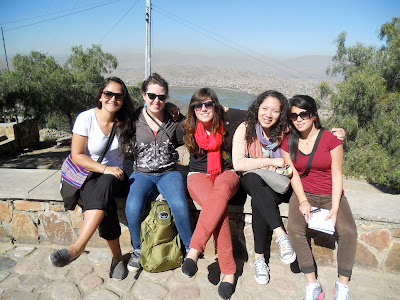On Sunday May 29th myself and the 11 other interns went to the largest statue of "El Christo de la Concordia" (even bigger than the one in Rio). The view was absolutely amazing. Above, Flor and I had to take a super touristy picture... And the two pictures below are of my fellow interns. The bottom of the two are the USF interns. I couldn't have asked for a better group from USF. We get along so well, and all of them are helping shape this beautiful experience in such a great way.
The above two pictures are from a soccer game we went to on Sunday 5/29. Cochabamba played Santa Cruz, and unfortunately it ended in a 0-0 tie. Sports events are much more exciting in South America then in the US, however the game kept stopping as the players are trained to dramatize every foul/injury.
Above: Dogs line the streets of Cochabamba, and unfortunately it is extremely dangerous to touch any of them, as many of them are infected with "rabia." I miss my dog so much, making it even more difficult to ignore the "perritos" for sale or the packs of dogs sleeping on the sidewalks.




Above: Cochabamba's streets are filled with vendors, music, flowers, beautiful colors, and much more. The picture above shows the view of the "Christo" on the mountain from a street below. También the two pictures of Flor and I are from a city wide scavenger hunt all the interns participated in. In the bottom one we look extremely confused because we were aimlessly walking through the Universidad Mayor de San Simón looking for a particular mural, however we were very entertained by the music blasting through out the campus and the lively student body. In partners, we had to locate four different areas/landmarks in the city. We also had to take at least two different types of public transportation to get to the specific locations. The traffic in Cochabamba is crazy, and pedestrians never have the right of way (a concept very new to me), so if you aren't looking a car could hit you at any moment. There are a variety of different forms of public transportation such as, taxis, trufis: a larger public van that circulates on the same route and passengers can enter and exit whenever they like, taxi-trufi: same as the trufi, however a smaller car only suitable for 5 passengers, y micro: this is unlike your average bus, they are painted on the outside and have bright red seats on the inside, and contrary to american buses, passengers can get on and off wherever they like.

















